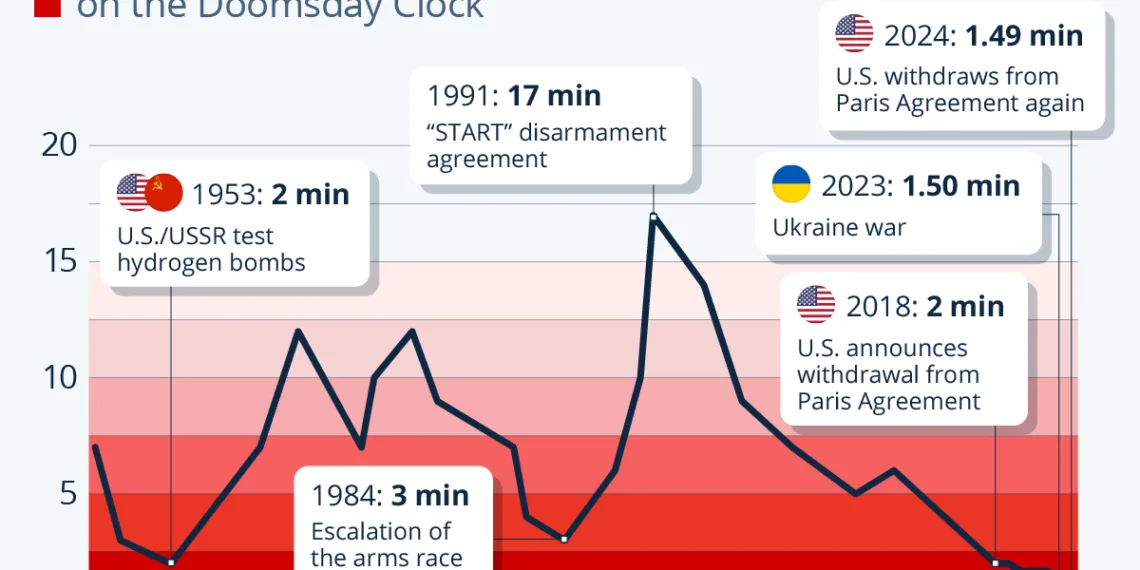The Doomsday Clock: A Symbol of Global Catastrophe
The Doomsday Clock, an iconic symbol representing the threats of nuclear war, climate change, and other existential risks to humanity, has recently inched closer to midnight. As of now, the hands of this figurative clock stand at a startling 89 seconds to midnight, the closest they have ever been. This adjustment has profound implications for our current world and the challenges we face.
The Significance of the Doomsday Clock
Understanding the Clock’s Mechanism
The Doomsday Clock is maintained by the Bulletin of the Atomic Scientists, an organization comprised of scientists and experts in nuclear technology. The representation of time left until "midnight" serves as a metaphor for the state of global security and the existential threats we face. When adjusted, the clock reflects the perceived urgency of global crises and man-made threats.
Recent Adjustments and Their Implications
In early 2023, the clock was moved from 90 seconds to 89 seconds before midnight, highlighting the delicate nature of international stability. This adjustment is not made lightly; it encapsulates escalating threats like the ongoing nuclear arms race, reckless climate policy, and the misuse of emerging technologies.
Root Causes of the Clock’s Advancement
Nuclear Weapons and Geopolitical Tensions
Nuclear weapons have posed a significant threat since their inception, and their continued existence represents a substantial existential risk. The 2023 adjustment to the Doomsday Clock reflects the escalating tensions between nuclear powers, particularly following Russia’s invasion of Ukraine. This act has not only increased regional instability but also has global implications for nuclear deterrence strategies.
Climate Change: An Ongoing Crisis
Climate change remains one of the most pressing issues contributing to the Doomsday Clock’s positioning. The withdrawal of the United States from the Paris Climate Agreement has raised concerns among scientists regarding global commitments to reducing greenhouse gas emissions. The consensus is clear: inadequate action to mitigate climate change could lead to catastrophic consequences for humanity.
The Influence of New Technologies
The rapid advancement in biological sciences and other emerging technologies also poses risks that could lead us closer to a global catastrophe. Issues such as biosecurity, artificial intelligence, and misinformation campaigns have emerged as potential hazards that threaten societal stability. The pandemic highlighted vulnerabilities in public health systems, further complicating future preparedness.
Historical Context of the Doomsday Clock
Key Moments in Time
The Doomsday Clock has been a barometer of global risk since its conception in 1947. Its history is marked by significant geopolitical moments, reflecting humanity’s precarious balance between crisis and security. For instance, in 1953, the clock was positioned at a notably dangerous time due to the hydrogen bomb tests by the U.S. and the USSR.
The Cuban Missile Crisis and Its Absence
Curiously, the Doomsday Clock did not reflect the severity of the Cuban Missile Crisis in 1962. By the time the Bulletin published its findings, the immediate danger had largely abated. This discrepancy offers critical insight into how the clock’s representation can sometimes lag behind on-the-ground realities, emphasizing the subjective nature of its adjustments.
The Future: A Call to Action
As the Doomsday Clock ticks closer to midnight, the urgency for action cannot be overstated. The interplay of nuclear threats, environmental degradation, and technological perils must prompt immediate and coherent responses from global leaders and citizens alike. Our path forward hinges on meaningful engagements in diplomacy, policy reform, and a collective commitment to safeguard humanity and our planet.
The Relevance of the Clock Today
While the Doomsday Clock serves as a stark reminder of the threats we face, it also acts as a call for increased awareness and proactive measures. The relationship between human ingenuity and global security will define our future. As we navigate these complex challenges, the symbols of our time, such as the Doomsday Clock, will continue to guide our conversations about safety and survival.









